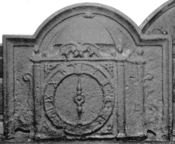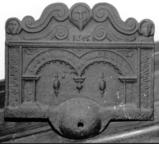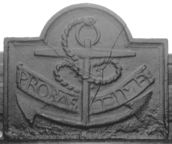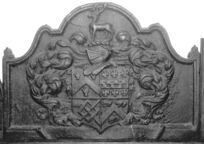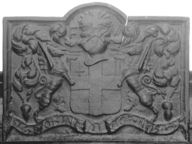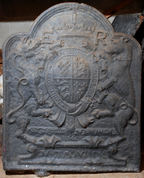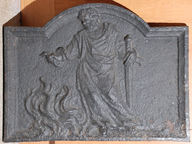-
119
Description: Arched rectangular shape; cavetto moulded edge on all sides; perspective view of a lantern clock.
Notes: The arms of the Worshipful Company of Clockmakers were granted in 1672: Sable a Clock each of the four pillars of the case based on a Lion couchant and capped with a Globe surmounted by a Cross and on the dome of the case an Imperial Crown all Or. The hands of the clock show six o’clock, as on the livery company shield. Formerly part of the Ade Collection (from Grove Hill, Hellingly, Sussex).
Copies of this fireback are known.
- Decoration tags:
- rectangular with round arch (shape)
- cavetto (edging)
- whole carved pattern
- objects
Manufactured: in the mid-17th century in the Weald area of England.
Current location: Hastings Museum and Art Gallery, John's Place, Bohemia Road, Hastings, East Sussex, England.
Museum number: HASMG: 1952.51.48 (LA 776) (part of the Hastings Museum museum group)
- Attached to series:
- Small cavetto series
- Livery company firebacks
-
123
Description: Rectangular; top panel with bearded face between symmetrical horizontal scrolls, and faces at either end; scrolls are repeated below, on either side of the date, all above a horizontal double fillet; below, a pair of arches with guilloche decoration between fillets, and toothed on the underside, are supported on each side by Tuscan columns, also with guilloche decoration; this is repeated in symmetrical rectangular panels on either side; at the centre base a bulbous nozzle protrudes.
Notes: This is a smith's forge fireback, the nozzle being the tuyere directing the air into the fire from bellows behind. Stylistically similar to the Lenard and other firebacks of the same period, the carved elements above the nozzle may have been cast from a pattern inspired by the back of a joined 'wainscot' chair, with the date inserted. The back may have been used for forging non-ferrous metals as there was a trade in pot-founding in bronze as well as iron at some ironworks in the Weald. Formerly part of the Ade Collection (from Grove Hill, Hellingly, Sussex).
Inscription: 1655
- Decoration tags:
- rectangular with round arch (shape)
- fillet (edging)
- whole carved pattern
- individual numbers
- architectural
- text
- humans
Manufactured: in 1655 in the Weald area of England.
Current location: Hastings Museum and Art Gallery, John's Place, Bohemia Road, Hastings, East Sussex, England.
Museum number: HASMG: 1952.51.62 (part of the Hastings Museum museum group)
Citation: Butterfield, W. R., 1916, 'Old Wealden Firebacks', The Connoisseur, 46, pp. 197-209.
- Attached to series:
- Chair pattern firebacks
- Furniture stamp firebacks
-
141
Description: Arched rectangular shape; ovolo moulded edging; central oval shield of the arms of Penkhurst with fillet edge; date arranged in four corners.
Notes: The arms of Penkhurst: Argent, a fess ermines between six mullets sable. Probably the arms of Ferdinando Penkhurst, of Buxted Park, Sussex, who died in 1708. Formerly part of the Ade Collection (from Grove Hill, Hellingly, Sussex).
Inscription: 1707
Arms: Penkhurst, of Mayfield
- Decoration tags:
- rectangular with round arch (shape)
- ovolo (edging)
- whole carved pattern
- individual numbers
- armorial
- text
Manufactured: in 1707 in the Weald area of England.
Current location: Hastings Museum and Art Gallery, John's Place, Bohemia Road, Hastings, East Sussex, England.
Museum number: HASMG: 1952.51.46 (part of the Hastings Museum museum group)
Citation: Dalton, A., 2002, 'The Penkhurst family of ironmasters', Wealden Iron, 2nd ser., 22, pp. 23-26.
Citation: Lloyd, N., 1925, 'Domestic Ironwork I', Architectural Review, 58, pp. 58-67.
- Attached to series:
- Personal armorial firebacks
-
142
Description: Arched rectangular shaped; cavetto moulded edging (top and sides); a cabled anchor palewise, behind it the inscription on a scroll parallel with the anchor flukes.
Notes: The inscription is a quotation from Psalms 139: 1: 'Domine, probasti me et cognovisti me' - Lord, Thou hast searched me and known me. Another version of the same design may come from the same source. Formerly part of the Ade Collection (from Grove Hill, Hellingly, Sussex).
Copies of this fireback are known.
Inscription: PROBASTI ME [Thou hast searched me]
- Decoration tags:
- rectangular with round arch (shape)
- cavetto (edging)
- whole carved pattern
- heraldic
- text
- objects
Manufactured: in the mid- to late-17th century possibly at Brede Furnace in the Weald area of England.
Current location: Hastings Museum and Art Gallery, John's Place, Bohemia Road, Hastings, East Sussex, England.
Museum number: HASMG: 1952.51.38 (part of the Hastings Museum museum group)
- Attached to series:
- Small cavetto series
- Old Testament & Apocrypha firebacks
-
144
Description: Quasi-arched rectangular shaped with cyma recta curved shoulders and 'pinnacles'; ovolo moulded edging with a deep base panel; shield, helm, crest and mantling of the Maynard family; plain motto scroll below.
Notes: The arms, which are those of an esquire, can be identified from the first four quarters on the memorial to Raffe Maynard, d.1613, in St Albans Cathedral, son of John Maynard (d.1556); quarterly, 1, Maynard: argent, a chevron azure between three sinister hands couped at the wrist gules; 2, Filleigh: gules, a fess vairy between six crosses formy or; 3, Hewis: gules fretty argent a canton of the second; 4, Lyons: argent a chevron sable between three lions dormant coward gules; the crest, a stag statant, is of Maynard. Contemporaneously, there were Maynards who operated ironworks in the Rotherfield area in Sussex, with whom this fireback may be connected. Significantly the motto scroll is blank, suggesting that the wooden pattern for the fireback had been originally intended as a decorative panel with the motto painted rather than carved in relief. The top right corner of the shield was evidently broken on the original pattern prior to being impressed into the casting sand to form the mould. A smaller casting with the same arms is also known (no. 667). Formerly part of the Ade Collection (from Grove Hill, Hellingly, Sussex).
Copies of this fireback are known.
Arms: Maynard family
- Decoration tags:
- rectangular with round arch (shape)
- ovolo (edging)
- whole carved pattern
- armorial
Manufactured: in the late-16th to early-17th century in the Weald area of England.
Current location: Hastings Museum and Art Gallery, John's Place, Bohemia Road, Hastings, East Sussex, England.
Museum number: HASMG: 1952.51.14 (part of the Hastings Museum museum group)
-
146
Description: Arched rectangular shape; cavetto moulded edging; shield, helm, crest, supporters, mantling and motto of the Corporation of the City of London; initials split by crest; date split at ends of motto.
Notes: Shield: Argent, a cross gules, in the first quarter a sword in pale point upwards of the last; crest: on a wreath argent and gules a dragon's sinister wing argent, charged on the underside with a cross throughout gules; supporters: on either side a dragon argent charged on the undersides of the wings with a cross throughout gules; motto: Domine Dirige Nos - Lord Direct Us; the earliest illustration of the arms in this form was in 1609, but their use is older. Formerly part of the Ade Collection (from Grove Hill, Hellingly, Sussex).
Copies of this fireback are known.
Inscription: F W / 16 DOMINE DIRIGE NOS 59
Arms: Corporation of the City of London
- Decoration tags:
- rectangular with round arch (shape)
- cavetto (edging)
- whole carved pattern
- individual letters
- armorial
- text
Manufactured: in 1659 possibly in the Weald area of England.
Current location: Hastings Museum and Art Gallery, John's Place, Bohemia Road, Hastings, East Sussex, England.
Museum number: HASMG: 1952.51.53 (part of the Hastings Museum museum group)
- Attached to series:
- Civic firebacks
-
147
Description: Arched rectangular shape with rounded corners; ovolo within fillet moulding all round; oval Tudor royal shield with garter surrounding, topped with a royal crown; dragon and greyhound supporters; initials split by crown; inscription on a fillet between legs of supporters, behind garter finial; motto on an Ionic plinth at bottom.
Notes: The supporters are those of Henry VII or Henry VIII, but the initials suggest the fireback dates from the reign of Edward VI (1547-53). John Harvo (d. c1565) was a gunfounder who has been identified as occupying Pounsley furnace, Framfield, Sussex, possibly from as early as 1547. This fireback is also seen with a variety of rectangular, rope-edged side panels bearing stamps or letters, some of which link the source of this and other groups of firebacks. The pattern or model for this fireback may have been made during the reign of Henry VIII (1509-47), with the initials added to an early casting using the original pattern. The protuberance on the bottom of the plate may be the remains of the runner from a pouring basin or overflow channel used during casting. Formerly part of the Ade Collection (from Grove Hill, Hellingly, Sussex).
Copies of this fireback are known.
Inscription: E R / HONY SOYT QVE MAL Y PAVNCE / Made in Sussex by John Harvo / DV ET MOVN DRO
Arms: Tudor royal (Edward VI)
- Decoration tags:
- rectangular with round arch (shape)
- fillet and cavetto (edging)
- whole carved pattern
- individual letters
- armorial
- text
Manufactured: in the mid-16th century probably at Pounsley Furnace, Framfield in the Weald area of England.
Current location: Hastings Museum and Art Gallery, John's Place, Bohemia Road, Hastings, East Sussex, England.
Museum number: HASMG: 1952.51.52 (part of the Hastings Museum museum group)
Citation: Butterfield, W. R., 1916, 'Old Wealden Firebacks', The Connoisseur, 46, pp. 197-209.
-
162
Description: Arched rectangular shaped; cavetto-moulded edge; figure of St Paul, a sword in his left hand, holding a viper in his right hand over flames rising from the ground.
Notes: The scene illustrates an episode in the New Testament, Acts 28: 3. The design shows stylistic similarities to other firebacks where simple, well-executed relief has overlapped the cavetto edging. Formerly part of the Ade Collection (from Grove Hill, Hellingly, Sussex).
Copies of this fireback are known.
- Decoration tags:
- rectangular with round arch (shape)
- cavetto (edging)
- whole carved pattern
- pictorial
- biblical
- humans
Manufactured: in the mid- to late-17th century possibly in the Weald area of England.
Current location: Hastings Museum and Art Gallery, John's Place, Bohemia Road, Hastings, East Sussex, England.
Museum number: HASMG: 1952.51.25 (part of the Hastings Museum museum group)
Citation: Butterfield, W. R., 1916, 'Old Wealden Firebacks', The Connoisseur, 46, pp. 197-209.
- Attached to series:
- Small cavetto series
- New Testament firebacks
-
190
Description: Arched rectangle; bevelled edge to arch and top of shoulders; initials at centre top of arch, in triangle 'S' at top; date below initials.
Notes: Possibly the work of David Robertson (1716-93), the King's Smith, whose iron grates are commonly to be found in houses designed by the prominent Scottish architects, Robert, John and James Adam, of whom he was a kinsman; the form of the plate is typical of grate-backs Robertson made in a variety of sizes, notably at Dumfries House, Ayrshire, although the lack of evidence of fixings suggest that this may have been made to be free-standing. Until 1756/7 Robertson had his forge in a tenement in Niddery's Wynd, Edinburgh, between High Street and Cow Gate, next door to John Adam's premises, although it is not known if he had a foundry there.
Inscription: S / W A / 1745
- Decoration tags:
- rectangular with round arch (shape)
- individual letters
- individual numbers
- text
Manufactured: in 1745 possibly in the Edinburgh area of Scotland.
Current location: Hill Top, Sawrey, Hawkshead, Hawkshead, Cumbria, England.
Museum number: 641831 (part of the National Trust museum group)
- Attached to series:
- Date & initials firebacks
-
191
Description: Arched rectangle; cavetto moulded edging; Tudor royal shield, Garter and crown, with crowned lion and dragon supporters; motto along bottom; Tudor rose to left of crown, portcullis to right.
Notes: This painted fireback is reputed to have been a gift from King Henry VIII to the second Sir William Godolphin, who was present at the Siege of Boulogne in 1544 with a party of Godolphin tin miners.
Copies of this fireback are known.
Inscription: HONI SOIT QVI MAL E PENSE / DIEU ET MON DROIT
Arms: Tudor royal (Elizabeth I)
- Decoration tags:
- rectangular with round arch (shape)
- cavetto (edging)
- whole carved pattern
- armorial
- text
Manufactured: in the mid- to late-16th century possibly in the Weald area of England.
Current location: Godolphin House, Helston, Cornwall, England.
Museum number: 169480 (part of the National Trust museum group)
- Attached to series:
- Tudor royal armorial firebacks
